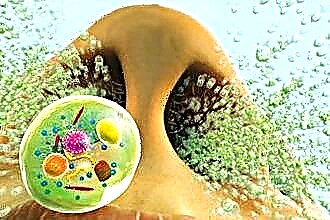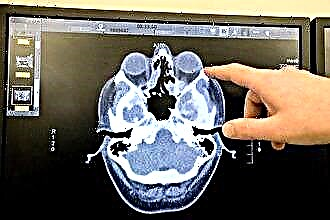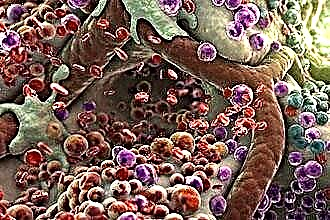One of the most common diseases of the respiratory system is maxillary sinusitis, better known as sinusitis. Despite the fact that this disease has been known since antiquity, for the first time its symptoms were described in detail in the 17th century by the British physician Nathaniel Highmore, after whom the disease began to be called. Next, we will consider what sinusitis is, what are its signs and methods of treatment.
Causes of the disease
 To begin with, you should pay attention to the anatomical structure of the maxillary sinuses. They are small pockets located in the thickness of the upper jaw on the sides of the nasal walls and occupy the space from the lower edge of the eye sockets to the oral cavity. Inside, the sinuses are covered with mucous membranes, they are connected to the nasal cavity by channels.
To begin with, you should pay attention to the anatomical structure of the maxillary sinuses. They are small pockets located in the thickness of the upper jaw on the sides of the nasal walls and occupy the space from the lower edge of the eye sockets to the oral cavity. Inside, the sinuses are covered with mucous membranes, they are connected to the nasal cavity by channels.
The anatomical feature of the maxillary sinus is that with a sufficiently large volume (15-20 cubic centimeters on average), the thickness of the connective anastomosis is only 1-3 mm.
Therefore, under the influence of a number of reasons, the anastomosis can narrow or completely overlap, which leads to problems with the removal of accumulated mucus.
To date, there are many reasons for provoking sinusitis. According to medical statistics, the main ones that cause maxillary sinusitis are viruses, bacteria and allergies.
- Viruses usually spread massively during seasonal spikes in respiratory illness. SARS and influenza affect millions of people, while viruses are transmitted by contact and airborne droplets. The mucous membranes of the nasal cavity swell, and in people with weakened immunity, the pathogen can easily pass through the fistula and provoke inflammation of the maxillary sinus. The connecting channel swells and fluid begins to accumulate in the chamber. Viral sinusitis itself is usually bilateral in nature and lasts 3-4 days, after which a bacterial factor joins it.
- Bacteria can enter the body from the external environment from contact with a sick person, or against the background of a weakening of local immunity, bacteria that constantly inhabit the mucous membranes of the nasopharynx are activated. Most often, sinusitis in adults and children is caused by coccal infections (pneumococci, streptococci, staphylococci, diplococci), as well as chlamydia and mycoplasma. They sometimes attack together and form complexes that make diagnosis and treatment more difficult due to greater antibiotic resistance.
- A person's allergy to any natural or chemical allergen always leads to a response from the body, often of a seasonal nature. Excreted in large quantities histamine can cause swelling of the connecting canal and cause inflammation of the maxillary sinuses, which at first is difficult to see against the background of allergic rhinitis. Under the influence of allergic reactions, polyps and cysts can appear in the cells.
Among other causes of sinusitis, there are also:
- Anatomical individual characteristics of people. A deformed nasal septum, overgrown adenoids in a child, failure of the secretion glands, narrowed air passages of the nose or anastomosis can cause the development of sinusitis.

- Infections of the molars of the upper jaw, such as caries, periodontal disease or pulpitis, often rise through the thin septum and affect the accessory chambers. This type of sinusitis is called odontogenic. Sometimes it occurs due to accidental ingestion of filling material into the sinus.
- Facial bone injuries. As a result of damage or unsuccessful operations, fragments of the skull bones can enter the cavity and block the drainage canal at any time. This type is characteristic of athletes, military men, road traffic accidents.
- Fungi. They can grow in accessory pockets when favorable conditions arise and local immunity is weakened, due to serious illness, HIV / AIDS, or a long course of strong antibiotics.
- Untimely or improper treatment of colds and respiratory diseases. Many people do not take rhinitis for a disease at all and think that it will go away on its own. Such complacency can be very expensive, since with a cold, the nasal mucous membranes are swollen and very susceptible to any pathogens.
- Decrease in the protective functions of the body. This can be caused by chronic or recent illnesses, taking strong medications, inappropriate working conditions, poor nutrition, physical inactivity, and frequent hypothermia.
Symptoms of the disease
Maxillary sinusitis has an extensive clinical picture. Its symptomatology is similar to other sinusitis, however, some signs allow even without a special examination to assume with a high probability that a person has sinusitis.
If a person has an inflammation of the maxillary sinus, the first signs are growing pains in the nasal region, intensifying in the evening and weakening in the morning. At first, discomfort is localized in the area of the affected cavity, but gradually the pain syndrome becomes diffuse and covers the entire head. Nasal breathing becomes difficult, the patient suffers from a runny nose, the temperature rises, the voice changes and becomes nasal.

Maxillary sinusitis is characterized by a wide variety of symptoms, indicating that this ailment affects most systems in the human body:
- a yellow or green nasal discharge, often with pus or blood streaks;
- pressure, heaviness, and pain in the sinuses and bridge of the nose when palpating with fingers or bending forward;
- nasal breathing is difficult or completely absent;
- the temperature is increased, from 37 to 39 degrees, depending on the stage of the disease, often with chills, weakness and malaise;
- pain syndrome extends to the orbits of the eyes, teeth, forehead, temples, can cover the entire head and intensify when turning the head (even a slight one);
- decreased ability to work, memory impairment, increased fatigue;
- sometimes coughing fits due to mucus running down the back of the throat;
- sleep disturbance, up to insomnia, and loss of appetite;
- loss or deterioration of the sense of smell, poor sense of taste of foods.
Even after studying most of the signs of the disease, even experts do not know everything about sinusitis. Medical practice is constantly adding new and new nuances about the manifestations of the disease.
Snot and fever as the main signs of the disease
Experienced otolaryngologists, by such basic signs as fever and snot, can accurately determine what it is - sinusitis, rhinitis or other respiratory disease.
The doctor determines the stage of the disease by the color of the mucus released from the accessory pockets:
- White and thick odorless snot can speak of the initial stage of the disease, it is difficult to distinguish them from a common cold. Also, the secret of white is possible at the stage of recovery, while its amount gradually decreases until it disappears completely.
 Green discharge indicates that a bacterial infection has joined, and pathogenic bacteria multiply in the sinuses, which can only be destroyed with antibiotics.
Green discharge indicates that a bacterial infection has joined, and pathogenic bacteria multiply in the sinuses, which can only be destroyed with antibiotics.- A yellow or brown tint is a signal that the disease has passed into a purulent stage, in this case, the discharge comes out in clots, possibly the presence of blotches or streaks of blood.
- Gray-green snot is a bad sign, it makes it clear to the doctor that mucus is stagnant in the cavity, and maxillary sinusitis is in a severe advanced stage.Often, only surgery can help.
Separately, cases should be considered when, in the presence of all the main symptoms of sinusitis, there is no discharge from the nasal passages. This means that the anastomosis is completely blocked by the strongest edema or due to physical interference: a cyst, an overgrown polyp, a foreign body or a bone fragment left after surgery or injury. To prevent severe complications, a sinus puncture is used (the scientific term "puncture" is often used), through which the exudate is evacuated.
Temperature is also a fairly clear criterion that determines the stage at which the disease is at the moment:
- Subfebrile (37.0-37.5 degrees) indicates a mild course of the disease or its chronic form during the period of remission. There is an option without an increase in temperature at all or even with hypothermia, which develops against the background of a malignant tumor. Fungal, radiation and polyposis types of disease also do not give a high temperature.
- Febrile (37-38 degrees) is characteristic of an illness of moderate severity, most often catarrhal or allergic sinusitis complicated by pathogenic bacteria.
- High (above 38 degrees) is a sign of an acute purulent form or exacerbation of a chronic ailment. Such hyperthermia can be removed only by the complex use of antipyretic drugs and antibiotics.
With adequate therapy, the temperature usually lasts no longer than a week, but if there is no improvement, it is worth undergoing an additional examination for a pathogen that may be resistant to certain antibiotics. In this case, therapy is adjusted based on new information.
Disease classification
Like any other disease, sinusitis can be classified depending on a number of signs.

According to the localization of the focus of inflammation in the accessory chambers, it is divided into:
- right-sided;
- left-sided;
- bilateral.
The symptomatology of all these cases is the same, the differences are only in the place of dislocation of external signs of damage.
By the type of inflammatory process, all sinusitis are divided into:
- Productive, characterized by the proliferation of tissues of the mucous membrane with the formation of tumors, cysts and polyps, which are perceived by the body as foreign bodies. Patients complain of loss of smell and difficulty swallowing.
- Exudative, when liquid serous or purulent exudate accumulates inside the air pockets. With a serous form, the exudate consists mainly of mucus with the inclusion of a large number of leukocytes. With purulent - from mucus and purulent contents.
Depending on the course of the disease, all sinusitis is subdivided into:
- acute, which are characterized by vivid manifestations of all basic symptoms and active progressive development;
- chronic, when the signs of the disease are blurred, they can subside for a while and practically do not appear, and then sharply worsen, causing severe pain syndrome.
According to the morphological changes occurring in the body, it is classified into the following types:
- Catarrhal. With it, the swelling of the nose is pronounced, but there is no pus. As a rule, this is a variant of development from a cold or exposure to a viral infection.
- Purulent. Disease-causing bacteria enter the air cavities and begin to actively multiply there, provoking severe inflammation.

- Polypous. Overgrowth of mucous membranes with the formation of soft tissue polyps in the form of grape bunches. Polyps sometimes fall into the nasal cavity through the connecting canal and make nasal breathing very difficult.
- Hyperplastic. With it, the diameter of the anastomosis decreases due to the thickening of the mucous membrane.
- Atrophic. Its cause is the termination of the performance of the mucous membranes of their main functions: the binding and removal of pathogens with the help of mucus. If the epithelium is atrophied, then the goblet cells do not secrete enough mucus for the normal functioning of the ciliated epithelial cells.
Complications of sinusitis
Despite all its routine, inflammation of the maxillary cavities is a very dangerous disease. You cannot take it lightly, since the source of the infection is located in the human skull in the immediate vicinity of vital organs (brain, ears, eyes), large blood arteries and nerves.
The breakthrough of purulent contents can lead to direct infection of nearby organs or other body systems through the blood stream.
Common complications of maxillary sinusitis:
- Otitis. As a result of the ingress of infected secretions into the tympanic cavity through the auditory (Eustachian) tubes, inflammation of the inner ear can develop. If pus is present, the eardrum can rupture, threatening hearing impairment. This consequence is especially common in children under 10 years of age, whose auditory tubes are wide and short, therefore, mucus can get there even with careless blowing or sneezing.
 Ophthalmitis. Inflammation of the eyeball and the membranes around it occurs when the purulent contents of the accessory pocket break through the thin bony dividing wall. With an unfavorable course, damage to the bony walls of the orbit and the optic nerve is possible, threatening complete blindness.
Ophthalmitis. Inflammation of the eyeball and the membranes around it occurs when the purulent contents of the accessory pocket break through the thin bony dividing wall. With an unfavorable course, damage to the bony walls of the orbit and the optic nerve is possible, threatening complete blindness.- Meningitis. The proximity to foci of infection of the meninges of the brain carries the danger of their inflammation. This does not happen very often, however, the level of deaths with such a development of the situation is very high and reaches, according to some sources, 35% of all cases. Meningitis is characterized by hallucinations, seizures, blackouts, and severe pain.
Also, due to sinusitis, another severe intracranial complication, encephalitis, can also appear.
Without proper treatment, sinusitis negatively affects other body systems and causes ailments that are often difficult for an ordinary person to directly associate with a common, in their opinion, runny nose and fever:
- Cardiovascular system - myocarditis, damage to the heart muscle with a violation of its rhythm.
- Nervous system - inflammation of the trigeminal nerve with constant burning pain in the face area, it is very long and difficult to treat.
- Respiratory system - pneumonia, bronchitis, tonsillitis, apnea syndrome (temporary cessation of breathing during sleep), temporary or complete loss of smell.
- Urogenital system - cystitis as a result of bacteria settling on the walls of the ureters and inflammation of the renal pelvis.
- The skeletal system - osteoperiostitis, inflammation of bone tissue under the direct long-term exposure to pus.
- The immune system is a weakening of the body's defenses, which results in susceptibility to respiratory and infectious diseases, especially of a seasonal nature.
Diagnosis and treatment of maxillary sinusitis
Despite the rather characteristic signs, only an otolaryngologist can accurately diagnose after studying the general clinical picture of the disease and additional research. The standard of treatment involves the following actions of the doctor:
- questioning the patient and studying the symptoms;
 endoscopic rhinoscopy (examination of the nose);
endoscopic rhinoscopy (examination of the nose);- blood test;
- fluoroscopy or computed tomography of the sinuses (sonography for pregnant women);
- nasal swab for bacterial culture to clarify the pathogen.
Conservative treatment of sinusitis includes a set of measures aimed at simultaneously relieving the most unpleasant symptoms for the patient and suppressing pathogenic microflora. In this case, drugs of various kinds are used:
- Antibiotics Mandatory for use in the bacterial form of the disease. Most often, macrolides (Sumamed, Macropen) and penicillins (Augmentin, Flemoxin solutab, Amoxiclav) are prescribed in tablets, as well as injectable cephalosporins (Cefazolin, Ceftriaxone).When using antibiotics, it is important to complete the full course without interrupting it after the condition improves, otherwise the disease may return, and the bacteria that have not been killed will become resistant to the drug used. To prevent intestinal dysbiosis, prebiotics and probiotics (Bifiform, Linex) should be taken in parallel with antibiotics.
- Antiseptics and antimicrobial agents. They are used as sprays, as well as for rinsing the nasal passages and air pockets (Dioxidin, Izofra, Polidexa, Protargol).
- Decongestants. They constrict blood vessels, limiting the flow of blood to the affected soft tissues, thereby helping to reduce swelling and restore normal nasal breathing. According to the duration of the action, they are divided into short-term (4-6 hours) - Tizin, Naphtizin, medium-term (6-8 hours) - Galazolin, Otrivin, Lazolvan rino, long-term (up to 12 hours) - Nazol, Nazivin, Rinazolin. However, with prolonged use (more than 7 days), side effects are possible in the form of vascular fragility and nosebleeds, so it is better to alternate drugs with different active ingredients.
- Analgesics. Needed to combat hyperthermia and pain. The most popular are paracetamol (Panadol), ibuprofen (Nurofen) and acetylsalicylic acid (Aspirin). They have various side effects and contraindications, so it is better to heed the doctor's advice. Also, it is not necessary to bring down the temperature to 38.5 degrees, since up to this limit the body fights pathogens on its own.
- Corticosteroids. They have a number of benefits, such as antihistamine and decongestant effects, and are good for allergic and bacterial sinusitis. Offered in pharmacies in the form of sprays and drops (Nazonex, Avamis).
- Mucolytics. Prescribed for thinning mucus and its easier evacuation from the nasal chambers, sold in the form of drops and syrups (Mukodin, Fluditek).

Surgical treatment involves the forced removal of exudate from the sinus. Such a surgical intervention is performed under local anesthesia in a hospital setting. A puncture (puncture) is made with a special needle in the thin part of the inner wall of the sinus. An antiseptic saline solution is injected with a syringe, then the liquefied contents of the chamber are sucked off, after which general and local antibiotics are injected through the same needle.
Many try to avoid the surgical method in every possible way, assuming that after the first puncture it will have to be done constantly.
In fact, puncture is a method that makes it possible to very quickly (within 2-3 hours) remove severe symptoms of the disease, which, with conservative treatment, are removed over several days.
The method of rinsing the nose with special solutions shows high efficiency. There are several types of flushing in a hospital setting:
- using the "Cuckoo" device (using an aspirator-suction and a syringe without a needle);
- using the YAMIK sinus catheter (has a vacuum principle of operation).

 Green discharge indicates that a bacterial infection has joined, and pathogenic bacteria multiply in the sinuses, which can only be destroyed with antibiotics.
Green discharge indicates that a bacterial infection has joined, and pathogenic bacteria multiply in the sinuses, which can only be destroyed with antibiotics. Ophthalmitis. Inflammation of the eyeball and the membranes around it occurs when the purulent contents of the accessory pocket break through the thin bony dividing wall. With an unfavorable course, damage to the bony walls of the orbit and the optic nerve is possible, threatening complete blindness.
Ophthalmitis. Inflammation of the eyeball and the membranes around it occurs when the purulent contents of the accessory pocket break through the thin bony dividing wall. With an unfavorable course, damage to the bony walls of the orbit and the optic nerve is possible, threatening complete blindness. endoscopic rhinoscopy (examination of the nose);
endoscopic rhinoscopy (examination of the nose);

